Video Technologies.pptx
- Количество слайдов: 22
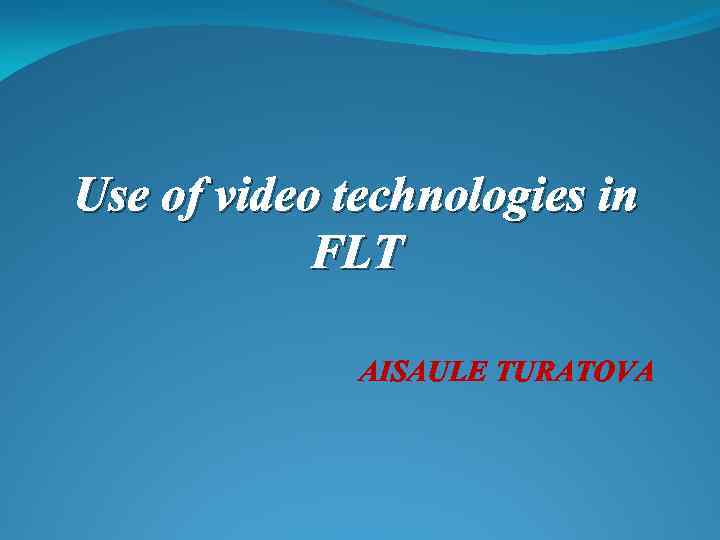 Use of video technologies in FLT AISAULE TURATOVA
Use of video technologies in FLT AISAULE TURATOVA
 Main methodological categories The word ‘method primarily means a way of doing something. The word method has two meanings: 1) a branch of science; 2) a way of teaching. A method is a generalized model of realization of the main components of teaching process, oriented on fulfillment of the main methodological aim. Technology is a complex of approaches, having a special purpose for getting effective result. E. g. project work, role plays, case study, decisionmaking tasks. It also divided into interactive and innovative.
Main methodological categories The word ‘method primarily means a way of doing something. The word method has two meanings: 1) a branch of science; 2) a way of teaching. A method is a generalized model of realization of the main components of teaching process, oriented on fulfillment of the main methodological aim. Technology is a complex of approaches, having a special purpose for getting effective result. E. g. project work, role plays, case study, decisionmaking tasks. It also divided into interactive and innovative.
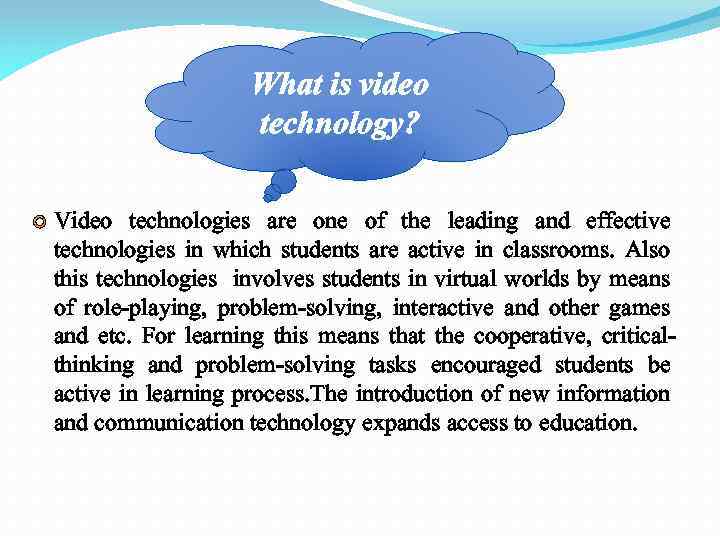 What is video technology? Video technologies are one of the leading and effective technologies in which students are active in classrooms. Also this technologies involves students in virtual worlds by means of role-playing, problem-solving, interactive and other games and etc. For learning this means that the cooperative, criticalthinking and problem-solving tasks encouraged students be active in learning process. The introduction of new information and communication technology expands access to education.
What is video technology? Video technologies are one of the leading and effective technologies in which students are active in classrooms. Also this technologies involves students in virtual worlds by means of role-playing, problem-solving, interactive and other games and etc. For learning this means that the cooperative, criticalthinking and problem-solving tasks encouraged students be active in learning process. The introduction of new information and communication technology expands access to education.
 WE MUST PAY ATTENTION TO STUDENTS: Age, perception Mentality, dif. nationality Cognitive development Ability, knowledge Interests, What he/she needs
WE MUST PAY ATTENTION TO STUDENTS: Age, perception Mentality, dif. nationality Cognitive development Ability, knowledge Interests, What he/she needs
 Video technologies in FLT Form students`s ICC and sub competences Realize the studentoriented approach Students become culturally aware Get communicative, problem-solving situation
Video technologies in FLT Form students`s ICC and sub competences Realize the studentoriented approach Students become culturally aware Get communicative, problem-solving situation
 Skills: 1. Prognostic to make prognosis about the event on the basis of theme, title. 2. Interpretation to understand the message on the whole to connect words into sentences, to create cognitive image. 3. Productive ability to translate, reproduce the material in his ownly in oral and written form. 4. Compensatory to compensate the lack of knowledge of grammar/vocabulary by using linguistic and contextual guess while reading and listening.
Skills: 1. Prognostic to make prognosis about the event on the basis of theme, title. 2. Interpretation to understand the message on the whole to connect words into sentences, to create cognitive image. 3. Productive ability to translate, reproduce the material in his ownly in oral and written form. 4. Compensatory to compensate the lack of knowledge of grammar/vocabulary by using linguistic and contextual guess while reading and listening.
 Functions of video technologies: Communica tive Teaching, developing Cognitive Motivating emotive Educational
Functions of video technologies: Communica tive Teaching, developing Cognitive Motivating emotive Educational
 Requirements to video materials: 1. 2. 3. 4. 5. 6. 7. 8. 9. Authentic; Student-oriented; Interactive and provide interactive learning; Social-culturally appropriate; Up-to-date; Correspond to the level of FL; Age appropriate; Interesting and visually attractive ; Relevant to real life.
Requirements to video materials: 1. 2. 3. 4. 5. 6. 7. 8. 9. Authentic; Student-oriented; Interactive and provide interactive learning; Social-culturally appropriate; Up-to-date; Correspond to the level of FL; Age appropriate; Interesting and visually attractive ; Relevant to real life.
 Stages of work: 1. Prewatching; 2. While watching; 3. Postwatching.
Stages of work: 1. Prewatching; 2. While watching; 3. Postwatching.
 Pre-watching stage 1. Prepare students describing the background, stimulating their interest. 2. Promote discussion after each filmstrip, question, descriptions. 3. General discussion, student form of group works to discuss it. Also show film again after the discussion period for further discussion.
Pre-watching stage 1. Prepare students describing the background, stimulating their interest. 2. Promote discussion after each filmstrip, question, descriptions. 3. General discussion, student form of group works to discuss it. Also show film again after the discussion period for further discussion.
 Pre-watching activities Activity 1. «Mind map» Activity 2. Teacher asks students to put new words in correct places Activity 3. Teacher asks questions what they know about the topic. Activity 4. In accordance with new words, theme, the title teacher asks students to guess what film be about.
Pre-watching activities Activity 1. «Mind map» Activity 2. Teacher asks students to put new words in correct places Activity 3. Teacher asks questions what they know about the topic. Activity 4. In accordance with new words, theme, the title teacher asks students to guess what film be about.
 While-watching activities Activity 1. Teacher asks students to watch the sequence and complete the notes, answer question. Activity 2. «The grid» is to organize the message in chunks of meaning as a result of watching process (who, when, what, how, why). Activity 3. «Silent viewing» the students could say what the characters were saying then check their guess Activity 4. «Freeze frame» teacher can freeze the picture and asks the students what they think will happen next. Activity 5. «Fast forward techniques» watch the sequence very fast and students should guess what it was about.
While-watching activities Activity 1. Teacher asks students to watch the sequence and complete the notes, answer question. Activity 2. «The grid» is to organize the message in chunks of meaning as a result of watching process (who, when, what, how, why). Activity 3. «Silent viewing» the students could say what the characters were saying then check their guess Activity 4. «Freeze frame» teacher can freeze the picture and asks the students what they think will happen next. Activity 5. «Fast forward techniques» watch the sequence very fast and students should guess what it was about.
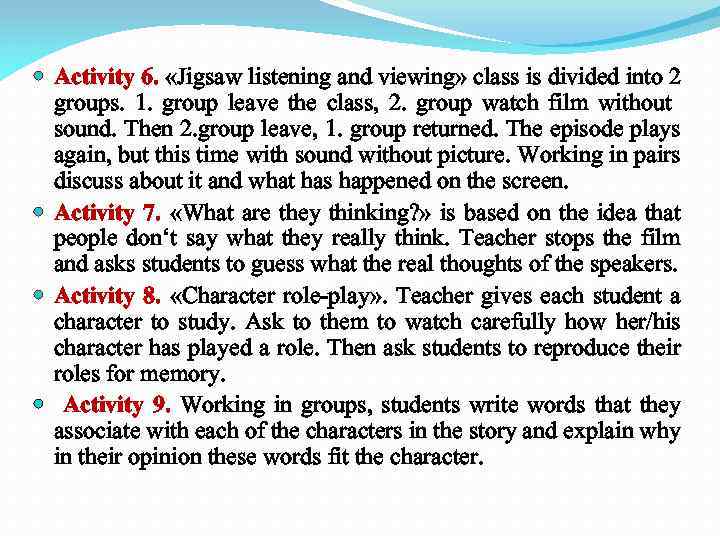 Activity 6. «Jigsaw listening and viewing» class is divided into 2 groups. 1. group leave the class, 2. group watch film without sound. Then 2. group leave, 1. group returned. The episode plays again, but this time with sound without picture. Working in pairs discuss about it and what has happened on the screen. Activity 7. «What are they thinking? » is based on the idea that people don‘t say what they really think. Teacher stops the film and asks students to guess what the real thoughts of the speakers. Activity 8. «Character role-play» . Teacher gives each student a character to study. Ask to them to watch carefully how her/his character has played a role. Then ask students to reproduce their roles for memory. Activity 9. Working in groups, students write words that they associate with each of the characters in the story and explain why in their opinion these words fit the character.
Activity 6. «Jigsaw listening and viewing» class is divided into 2 groups. 1. group leave the class, 2. group watch film without sound. Then 2. group leave, 1. group returned. The episode plays again, but this time with sound without picture. Working in pairs discuss about it and what has happened on the screen. Activity 7. «What are they thinking? » is based on the idea that people don‘t say what they really think. Teacher stops the film and asks students to guess what the real thoughts of the speakers. Activity 8. «Character role-play» . Teacher gives each student a character to study. Ask to them to watch carefully how her/his character has played a role. Then ask students to reproduce their roles for memory. Activity 9. Working in groups, students write words that they associate with each of the characters in the story and explain why in their opinion these words fit the character.
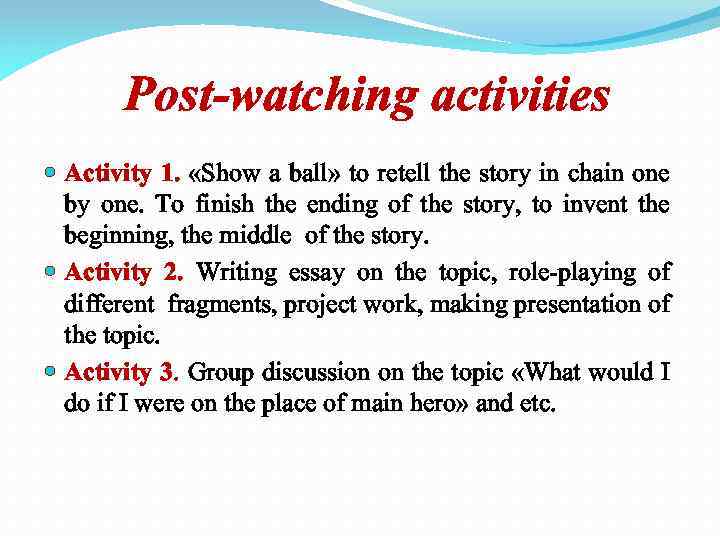 Post-watching activities Activity 1. «Show a ball» to retell the story in chain one by one. To finish the ending of the story, to invent the beginning, the middle of the story. Activity 2. Writing essay on the topic, role-playing of different fragments, project work, making presentation of the topic. Activity 3. Group discussion on the topic «What would I do if I were on the place of main hero» and etc.
Post-watching activities Activity 1. «Show a ball» to retell the story in chain one by one. To finish the ending of the story, to invent the beginning, the middle of the story. Activity 2. Writing essay on the topic, role-playing of different fragments, project work, making presentation of the topic. Activity 3. Group discussion on the topic «What would I do if I were on the place of main hero» and etc.
 LINGUISTIC COMPONENT: Language material Pronunciation Improving students' pronunciation habits with the help of the new language material Vocabulary Grammar The expansion of knowledge of studied grammatical phenomena Expansion of productive and receptive vocabulary by lexical means with the help of new topics, problems and situations of oral and written communication. Also including professional-oriented as well as the evaluation of vocabulary
LINGUISTIC COMPONENT: Language material Pronunciation Improving students' pronunciation habits with the help of the new language material Vocabulary Grammar The expansion of knowledge of studied grammatical phenomena Expansion of productive and receptive vocabulary by lexical means with the help of new topics, problems and situations of oral and written communication. Also including professional-oriented as well as the evaluation of vocabulary
 LINGUISTIC COMPONENT: Speech material Educational & Labor sphere Social sphere Daily activities, family, friendship, relationship, every day life Social & Cultural sphere Problem of modern society, life in city & countryside, nature, technical progress, historical events Problems of choice profession. The role of FL in our life. Plans for future. Innovative technologies
LINGUISTIC COMPONENT: Speech material Educational & Labor sphere Social sphere Daily activities, family, friendship, relationship, every day life Social & Cultural sphere Problem of modern society, life in city & countryside, nature, technical progress, historical events Problems of choice profession. The role of FL in our life. Plans for future. Innovative technologies
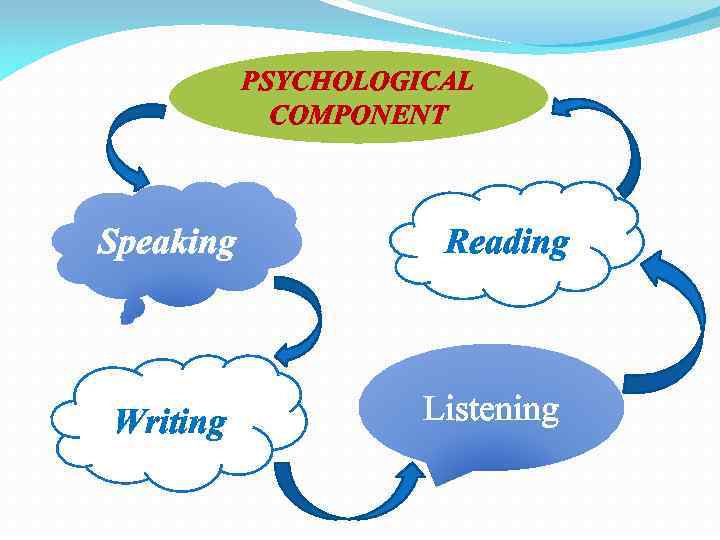 PSYCHOLOGICAL COMPONENT Speaking Reading Writing Listening
PSYCHOLOGICAL COMPONENT Speaking Reading Writing Listening
 Speaking Dialogue Monologue Development of all kinds of dialogical skills with the help of new materials, themes. In addition to expand situations of formal and informal communication Development of students' monological skills of performing oral reports in connection with the seen/read/heard, by results of working on the foreignlanguage project.
Speaking Dialogue Monologue Development of all kinds of dialogical skills with the help of new materials, themes. In addition to expand situations of formal and informal communication Development of students' monological skills of performing oral reports in connection with the seen/read/heard, by results of working on the foreignlanguage project.
 Listening Ø understand the main content, idea of sounding texts of For development monological and dialogical character, of radio programs of this skill in the field of the studied topics, materials; have ability Ø to separate main information understand of the ideas, contents of the most common from another. situations of everyday life communication, necessary/ interesting information in modern life and strong connected with chosen profession.
Listening Ø understand the main content, idea of sounding texts of For development monological and dialogical character, of radio programs of this skill in the field of the studied topics, materials; have ability Ø to separate main information understand of the ideas, contents of the most common from another. situations of everyday life communication, necessary/ interesting information in modern life and strong connected with chosen profession.
 Reading Ø Ø to separate the main information from a minor; to find cause & effect relationship between the facts; to understand the arguments; to extract the required information; Skimming: to understand of the main content of the message, reports; Scanning: accurate understanding of message of texts; Guided: looking for information in the text which is related to the given questions.
Reading Ø Ø to separate the main information from a minor; to find cause & effect relationship between the facts; to understand the arguments; to extract the required information; Skimming: to understand of the main content of the message, reports; Scanning: accurate understanding of message of texts; Guided: looking for information in the text which is related to the given questions.
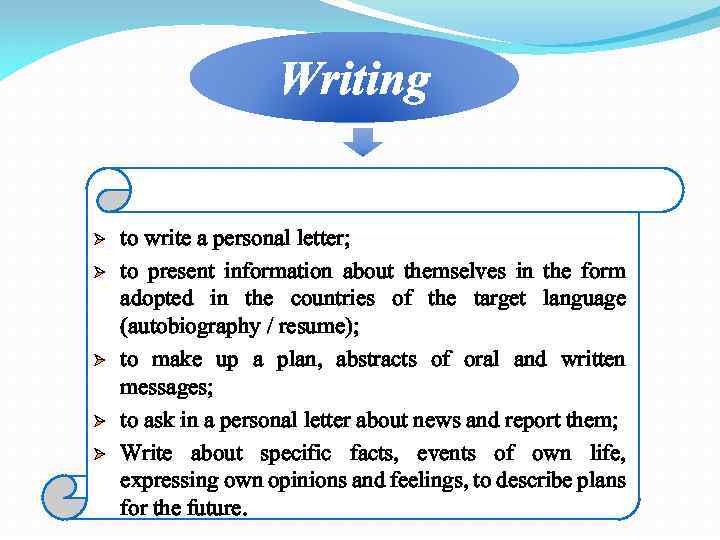 Writing Ø Ø Ø to write a personal letter; to present information about themselves in the form adopted in the countries of the target language (autobiography / resume); to make up a plan, abstracts of oral and written messages; to ask in a personal letter about news and report them; Write about specific facts, events of own life, expressing own opinions and feelings, to describe plans for the future.
Writing Ø Ø Ø to write a personal letter; to present information about themselves in the form adopted in the countries of the target language (autobiography / resume); to make up a plan, abstracts of oral and written messages; to ask in a personal letter about news and report them; Write about specific facts, events of own life, expressing own opinions and feelings, to describe plans for the future.
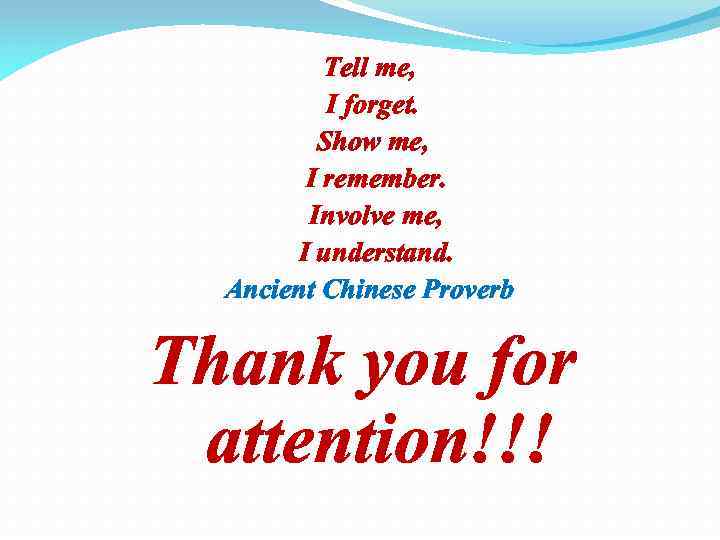 Tell me, I forget. Show me, I remember. Involve me, I understand. Ancient Chinese Proverb Thank you for attention!!!
Tell me, I forget. Show me, I remember. Involve me, I understand. Ancient Chinese Proverb Thank you for attention!!!


